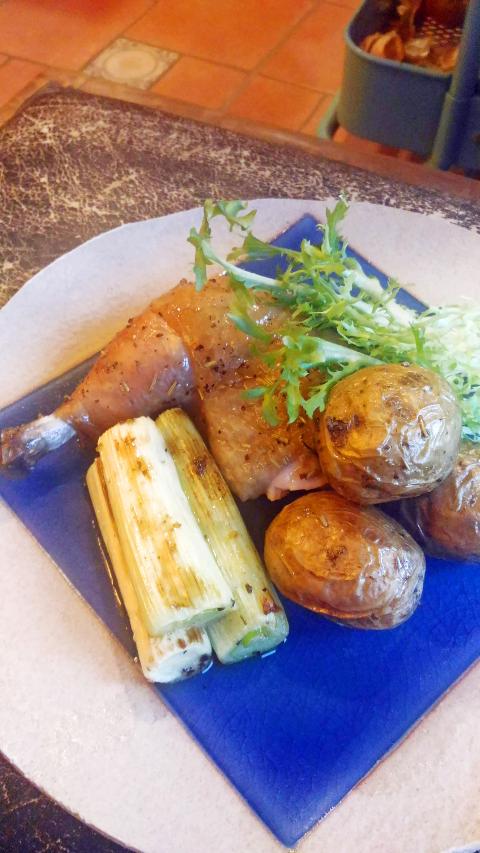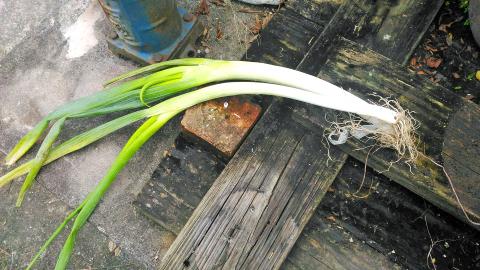Leeks, according to the Oxford Companion to Food, are “a member of the onion family, distinguished by [their] mild sweet flavor.” The Companion goes on to say that the leek “is beset by the problems of classification which seem to affect the whole [onion] family.” To avoid the issue of exactly what a leek (大蔥) is in Taiwan — as there are issues of translation and inconsistent terminology — I have confined myself here to the use of what is described as the Japanese leek (日本大蔥). Unlike the thick-stemmed leeks in the UK, these are slimmer and more delicate, resembling overgrown shallots.
Given that Japanese leeks are a labor-intensive cultivar with a relatively recent history in Taiwan, their price would generally exclude them from use in European leek staples such as vichyssoise or cock-a-leekie soup. An article in the Liberty Times in January suggested that the delicate Japanese leek is gradually gaining traction in the local market. This is particularly, and unsurprisingly, true in Japanese restaurants, which the article suggested were queuing up to purchase locally-grown Japanese leeks for use on their menus.
Traditionally, leeks accompany the classic dish of Peking duck, but in my experience, I have found a wide range of leek-like vegetables in this role. Most low-end “one-duck-in-three-styles” (烤鴨三吃) eateries do not even bother with the subterfuge, using the ubiquitous shallot in place of anything that has aspirations to being a leek. The thick, beefy leek used in European soups, while sometimes suitable for use raw (especially the white stem), is often too coarse a garnish for the duck, leek and hoisin sauce combo wrapped in a steamed Chinese bun, yet it is being pressed into service on some occasions.

Photo: Ian Bartholomew
Although a member of the onion family, leeks do not have a bulb, and are instead prized for their long, white stems, which are actually tightly-bunched leaves. This much-prized section, with its softness and translucent whiteness, is created by piling earth up around the leek as it grows, rather in the manner of white asparagus. This sort of work inevitably requires a very hands-on approach, and the cost of Japanese leeks reflects this additional labor.
That said, Japanese leeks are one of the more subtle and appealing flavors offered up by the onion family. This is not to say that regular brown onions or shallots have no appeal. But if you are looking for an ingredient to dress up a salad, Japanese leeks will answer the call with little more than a quick chop to the required shape and size.
In addition to their winning flavor, leeks are tremendously nutritious. The “world’s healthiest foods” Web site (www.whfoods.com) lauds its “unique combination of flavonoids and sulfur-containing nutrients,” qualities the leek shares with other members of the onion family.

Photo: Ian Bartholomew
While the Japanese leek is cultivated as a delicacy in Taiwan, the green leaves can be a little tough and may not be suitable for minimalist preparations such as salads or roasting as described below. They are nevertheless full of flavor and nutrition and should not be wasted. Adding them to a saute or to soup is an excellent way of making use of the whole plant when the white stems have been put aside for more elevated and distinguished applications.
ROAST CHICKEN WITH LEEK AND POTATOES
Recipe
(Serves 4)
This recipe is a bit of a cheat, mostly because the best way of cooking leeks is to do as little as possible. In this case, that very little involves no more than putting them under the grill. A bit of good olive oil and sea salt is really all that is needed to bring out some really amazing flavors that just happen to go well with a generous cut of roast chicken and potatoes. So there is not much to elaborate on the Japanese leek that has not been noted in the accompanying article.
I don’t know about others, but roast chicken for me as a child was always surrounded by an awesome mystique as something special, almost ritualistic, in the elements of its preparation. Then there is the banal simplicity of supermarket roast chicken, churned out from industrial rotisseries at great speed and sold for appealing prices. But a home-roasted chicken, if sourced well and coupled with just one or two flavorful elements, is a meal not easily surpassed. It takes only minutes to prepare. If nothing else, years in the kitchen have taught me that when good ingredients are on hand, the less you do to them, the better. The work is easier and the result is better — what is there to complain about in that?
This is my version of a roast chicken supper. The addition of basil provides a Mediterranean touch, but go for a mixture of cumin and coriander if you want a Middle Eastern twist, or perhaps stuff the chicken with half a lemon (instead of an onion) and rub with oregano and rosemary for some Greek flair.
Ingredients
1 whole chicken, naturally raised if not free-range
2 teaspoons oil
Half a small onion
1 tablespoon dried basil (optional)
12 baby potatoes
4-5 stems Japanese leeks, depending on thickness
Salt and pepper to season
Directions
1. If the chicken is frozen, defrost it thoroughly. The best method for this is to transfer it to the fridge the day before, a process that requires at least 24 hours for a well-frozen chicken. If purchased from a traditional market, the chicken should be washed thoroughly and for best roasting results, refrigerated uncovered overnight before roasting. Much depends on the bird in hand, but something that is unfrozen, or at least slowly defrosted, will serve best. Frozen imported supermarket chicken, especially if alluringly cheap, should be avoided.
2. Once the chicken is defrosted, rub vigorously with salt and pepper, and dried basil if using, then refrigerate for six hours or overnight to dry out slightly.
3. Wash the baby potatoes thoroughly.
4. Place a sturdy baking tray with a little oil in a preheated oven prepared to 200 degrees Celsius.
5. Put half an onion (or lemon) in the cavity of the chicken. Remove the baking tray from the oven and place the chicken breast-side up in the hot tray. Add the potatoes and toss to slightly coat with oil. Place in the oven and roast for a total of 40 minutes, basting the chicken and tossing the potatoes in oil after about 20 minutes.
6. Once the chicken is cooked (internal temperature for the thickest part of the meat should be around 62 degrees Celsius), set it aside to rest for at least 15 minutes.
7. Spoon out a little of the chicken fat and drizzle over the leeks. Add salt and pepper to taste. Place under the grill for about five minutes until they start to soften and color.
8. Remove the leeks and serve with cut sections from the chicken and the roast potatoes. It doesn’t get easier than that.
Ian Bartholomew runs Ian’s Table, a small guesthouse in Hualien. He has lived in Taiwan for many years writing about the food scene and has decided that until you look at farming, you know nothing about the food you eat.
He can be contacted at Hualien202@gmail.com.

June 9 to June 15 A photo of two men riding trendy high-wheel Penny-Farthing bicycles past a Qing Dynasty gate aptly captures the essence of Taipei in 1897 — a newly colonized city on the cusp of great change. The Japanese began making significant modifications to the cityscape in 1899, tearing down Qing-era structures, widening boulevards and installing Western-style infrastructure and buildings. The photographer, Minosuke Imamura, only spent a year in Taiwan as a cartographer for the governor-general’s office, but he left behind a treasure trove of 130 images showing life at the onset of Japanese rule, spanning July 1897 to

One of the most important gripes that Taiwanese have about the Democratic Progressive Party (DPP) is that it has failed to deliver concretely on higher wages, housing prices and other bread-and-butter issues. The parallel complaint is that the DPP cares only about glamor issues, such as removing markers of Chinese Nationalist Party (KMT) colonialism by renaming them, or what the KMT codes as “de-Sinification.” Once again, as a critical election looms, the DPP is presenting evidence for that charge. The KMT was quick to jump on the recent proposal of the Ministry of the Interior (MOI) to rename roads that symbolize

On the evening of June 1, Control Yuan Secretary-General Lee Chun-yi (李俊俋) apologized and resigned in disgrace. His crime was instructing his driver to use a Control Yuan vehicle to transport his dog to a pet grooming salon. The Control Yuan is the government branch that investigates, audits and impeaches government officials for, among other things, misuse of government funds, so his misuse of a government vehicle was highly inappropriate. If this story were told to anyone living in the golden era of swaggering gangsters, flashy nouveau riche businessmen, and corrupt “black gold” politics of the 1980s and 1990s, they would have laughed.

It was just before 6am on a sunny November morning and I could hardly contain my excitement as I arrived at the wharf where I would catch the boat to one of Penghu’s most difficult-to-access islands, a trip that had been on my list for nearly a decade. Little did I know, my dream would soon be crushed. Unsure about which boat was heading to Huayu (花嶼), I found someone who appeared to be a local and asked if this was the right place to wait. “Oh, the boat to Huayu’s been canceled today,” she told me. I couldn’t believe my ears. Surely,